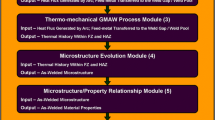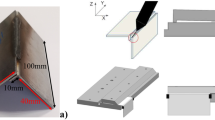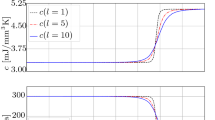Abstract
In our recent work, a multi-physics computational model for the conventional gas metal arc welding (GMAW) joining process was introduced. The model is of a modular type and comprises five modules, each designed to handle a specific aspect of the GMAW process, i.e.: (i) electro-dynamics of the welding-gun; (ii) radiation-/convection-controlled heat transfer from the electric-arc to the workpiece and mass transfer from the filler-metal consumable electrode to the weld; (iii) prediction of the temporal evolution and the spatial distribution of thermal and mechanical fields within the weld region during the GMAW joining process; (iv) the resulting temporal evolution and spatial distribution of the material microstructure throughout the weld region; and (v) spatial distribution of the as-welded material mechanical properties. In the present work, the GMAW process model has been upgraded with respect to its predictive capabilities regarding the spatial distribution of the mechanical properties controlling the ballistic-limit (i.e., penetration-resistance) of the weld. The model is upgraded through the introduction of the sixth module in the present work in recognition of the fact that in thick steel GMAW weldments, the overall ballistic performance of the armor may become controlled by the (often inferior) ballistic limits of its weld (fusion and heat-affected) zones. To demonstrate the utility of the upgraded GMAW process model, it is next applied to the case of butt-welding of a prototypical high-hardness armor-grade martensitic steel, MIL A46100. The model predictions concerning the spatial distribution of the material microstructure and ballistic-limit-controlling mechanical properties within the MIL A46100 butt-weld are found to be consistent with prior observations and general expectations.















Similar content being viewed by others
References
M. Grujicic, S. Ramaswami, J.S. Snipes, C.-F. Yen, B.A. Cheeseman, and J.S. Montgomery, Multi-physics Modeling and Simulations of MIL A46100 Armor-Grade Martensitic Steel Gas Metal Arc Welding Process, J. Mater. Eng. Perform., 2013, 22, p 2950–2969
M. Grujicic, S. Ramaswami, J.S. Snipes, R. Yavari, A. Arakere, C.-F. Yen, and B.A. Cheeseman, Computational Modeling of Microstructure Evolution in AISI, 1005 Steel During Gas Metal Arc Butt Welding, J. Mater. Eng. Perform., 2012, 22, p 1209–1222
M. Grujicic, A. Arakere, S. Ramaswami, J.S. Snipes, R. Yavari, C.F. Yen, B.A. Cheeseman, and J.S. Montgomery, Gas Metal Arc Welding Process Modeling and Prediction of Weld Microstructure in MIL A46100 Armor-Grade Martensitic Steel, J. Mater. Eng. Perform., 2013, 22, p 1541–1557
M.G.H. Wells, R.K. Weiss, and J.S. Montgomery, “LAV Armor Plate Study”, MTL TR 92-26, U.S. Army Materials Technology Laboratory, Watertown, MA, 1992
M. Grujicic, G. Arakere, B. Pandurangan, A. Hariharan, C.F. Yen, B.A. Cheeseman, and C. Fountzoulas, Computational Analysis and Experimental Validation of the Ti-6Al-4V Friction Stir Welding Behavior, J. Eng. Manuf., 2010, 224, p 1–16
M. Grujicic, T. He, G. Arakere, H.V. Yalavarthy, C.F. Yen, and B.A. Cheeseman, Fully-Coupled Thermo-mechanical Finite-Element Investigation of Material Evolution During Friction-Stir Welding of AA5083, J. Eng. Manuf., 2010, 224, p 609–625
M. Grujicic, G. Arakere, H.V. Yalavarthy, T. He, C.F. Yen, and B.A. Cheeseman, Modeling of AA5083 Material-Microstructure Evolution During Butt Friction-Stir Welding, J. Mater. Eng. Perform., 2010, 19, p 672–684
M. Grujicic, G. Arakere, B. Pandurangan, A. Hariharan, C.F. Yen, and B.A. Cheeseman, Development of a Robust and Cost-Effective Friction Stir Welding Process for Use in Advanced Military Vehicle Structures, J. Mater. Eng. Perform., 2011, 20, p 11–23
M. Grujicic, G. Arakere, C.F. Yen, and B.A. Cheeseman, Computational Investigation of Hardness Evolution During Friction-Stir Welding of AA5083 and AA2139 Aluminum Alloys, J. Mater. Eng. Perform., 2011, 20, p 1097–1108
M. Grujicic, G. Arakere, A. Hariharan, and B. Pandurangan, A Concurrent Product-Development Approach for Friction-Stir Welded Vehicle-Underbody Structures, J. Mater. Eng. Perform., 2012, 21, p 437–449
M. Grujicic, G. Arakere, A. Hariharan, and B. Pandurangan, Two-Level Weld-Material Homogenization Approach for Efficient Computational Analysis of Welded Structure Blast Survivability, J. Mater. Eng. Perform., 2012, 21, p 786–796
M. Grujicic, G. Arakere, B. Pandurangan, J.M. Ochterbeck, C.F. Yen, B.A. Cheeseman, A.P. Reynolds, and M.A. Sutton, Computational Analysis of Material Flow During Friction Stir Welding of AA5059 Aluminum Alloys, J. Mater. Eng. Perform., 2012, 21, p 1824–1840
M. Grujicic, B. Pandurangan, C.-F. Yen, and B.A. Cheeseman, Modifications in the AA5083 Johnson-Cook Material Model for Use in Friction Stir Welding Computational Analyses, J. Mater. Eng. Perform., 2012, 21, p 2207–2217
M. Gore, M. Grujicic, and G.B. Olson, Thermally Activated Grain Boundary Motion Through a Dispersion of Particles, Acta Metall., 1989, 37, p 2849–2854
W.S. Owen and M. Grujicic, Encyclopedia of Materials Science and Engineering, Section—“Plastic Deformation: Thermally Activated Glide of Dislocations”, Pergamon Press, Oxford, UK, 1986, p 3540–3543
R.L. Fleischer, Substitutional Solution Hardening, Acta Metall. Mater., 1963, 11, p 203–209
R. Labusch, A Statistical Theory of Solid Solution Hardening, Phys. Status Solidi, 1970, 41, p 659–669
M.F. Ashby, On the Orowan Stress, M.F. Ashby, Ed., The M.I.T. Press, Cambridge, MA, 1969, p 113–131
M. Takahashi and H.K.D.H. Bhadeshia, Model for Transition from Upper Bainite to Lower Bainite, Mater. Sci. Technol., 1990, 6, p 592–603
A.S. Keh and S. Weissman, Deformation Structure in Body-Centered Cubic Metals, A.S. Keh and S. Weissman, Ed., Interscience, New York, 1963, p 231–300
W.C. Leslie, J.T. Michalak, and F.W. Aul, The Annealing of Cold-Worked Iron, W.C. Leslie, J.T. Michalak, and F.W. Aul, Ed., Interscience, Detroit, 1961, p 119–212
R.E. Reed-Hill and R. Abbaschian, Physical Metallurgy Principles, 3rd ed., PWS-Kent Publishing Co., Boston, MA, 1992
M.F. Ashby and D.R.H. Jones, Engineering Materials: An Introduction to Their Properties and Application, Pergamon Press, New York, 1980
J.S. Unfried, C.M. Garzón, and J.E. Giraldo, Numerical and Experimental Analysis of Microstructure Evolution During Arc Welding in Armor Plate Steels, J. Mater. Process. Technol., 2009, 209, p 1688–1700
Cambridge Engineering Selector, http://www.grantadesign.com/. Accessed December 31, 2013.
A.M. Sarosiek, M. Grujicic, and W.S. Owen, The Importance of the Heterogeneity of the Deformation in the Ferrite Phase of a Dual-Phase Steel, Scripta Metall., 1984, 8, p 353–356
G.G. Corbett, S.R. Reid, and W. Johnson, Impact Loading of Plates and Shells by Free-Flying Projectiles: A Review, Int. J. Impact Eng., 1996, 18, p 141–230
K.S. Kumar, D. Singh, and T. Bhat, Studies on Aluminum Armour Plates Impacted by Deformable and Non-deformable Projectiles, Mater. Sci. Forum, 2004, 465–466, p 79–84
T. Børvik, O.S. Hopperstad, and K.O. Pedersen, Fracture Mechanisms of Aluminum Alloy AA7075-T651 Under Various Loading Conditions, Int. J. Impact Eng., 2010, 37, p 537–551
T. Børvik, M.J. Forrestal, O.S. Hopperstad, T.L. Warren, and M. Langseth, Perforation of AA5083-H116 Aluminium Plates with Conical-Nose Steel Projectiles—Calculations, Int. J. Impact Eng., 2009, 36, p 426–437
M.R. Edwards and A. Mathewson, The Ballistic Properties of Tool Steel as a Potential Improvised Armor Plate, Int. J. Impact Eng., 1997, 19, p 297–309
M.J. Forrestal, V.K. Luk, and N.S. Brar, Penetration of Aluminum Armor Plates with Conical-Nose Projectiles, Mechanics, 1990, 10, p 97–105
A.J. Piekutowski, M.J. Forrestal, K.L. Poormon, and T.L. Warren, Ogive-Nose Steel Rods at Normal, Int. J. Impact Eng., 1996, 18, p 877–887
T. Børvik, A.H. Clausen, O.S. Hopperstad, and M. Langseth, Perforation of AA5083-H116 Aluminium Plates with Conical-Nose Steel Projectiles—Experimental Study, Int. J. Impact Eng., 2004, 30, p 367–384
A.H. Chausen, T. Børvik, O.S. Hopperstad, and A. Benallal, Tore Flow and Fracture Characteristics of Aluminium Alloy AA5083-H116 as Function of Strain Rate, Temperature and Triaxiality, Mater. Sci. Eng., 2004, A364, p 260–272
T. Børvik, J.R. Leinum, J.K. Solberg, O.S. Hopperstad, and M. Langseth, Observations on Shear Plug Formation in Weldox 460 E Steel Plates Impacted by Blunt-Nosed Projectiles, Int. J. Impact Eng., 2001, 25, p 553–572
A.P. Rybakov, Spall in Non-one-dimensional Shock Waves, Int. J. Impact Eng., 2000, 24, p 1041–1082
M. Grujicic, G.B. Olson, and W.S. Owen, Kinetics of Martensitic Interface Motion, Proc. ICOMAT-82, Leuven, Belgium, J. Physique, 1982, 43(Suppl. 12), pp. C4-173–179
M. Grujicic and G. Haidemenopoulos, Treatment of Paraequilibrium Thermodynamics in an AF1410 Steel Using the Thermo-Calc Software and Database, Calphad, 1988, 12(3), pp. 219–224
M. Grujicic, I.J. Wang, and W.S. Owen, On the Formation of Duplex Precipitate Phases in an Ultra-low Carbon Micro-alloyed Steel, Calphad, 1988, 12(3), pp. 261–275
M. Grujicic, G. Cao, and G.M. Fadel, “Effective Materials Properties: Determination and Application in Mechanical Design and Optimization,” J. Mater.: Des. Appl., 2002, 215, pp. 225–234
Acknowledgments
The material presented in this paper is based on work supported by two Army Research Office sponsored grants entitled “Friction Stir Welding Behavior of Selected 2000-series and 5000-series Aluminum Alloys” (Contract Number W911NF-11-1-0207), and “Concept Validation and Optimization for a Vent-based Mine-blast Mitigation System” (Contract Number W911NF-11-1-0518). The authors are indebted to Dr. Ralph A. Anthenien, Jr. and Dr. Bryan Glaz of ARO for their continuing support and interest in the present work.
Author information
Authors and Affiliations
Corresponding author
Rights and permissions
About this article
Cite this article
Grujicic, M., Snipes, J.S., Galgalikar, R. et al. Ballistic-Failure Mechanisms in Gas Metal Arc Welds of Mil A46100 Armor-Grade Steel: A Computational Investigation. J. of Materi Eng and Perform 23, 3108–3125 (2014). https://doi.org/10.1007/s11665-014-1090-9
Received:
Revised:
Published:
Issue Date:
DOI: https://doi.org/10.1007/s11665-014-1090-9




